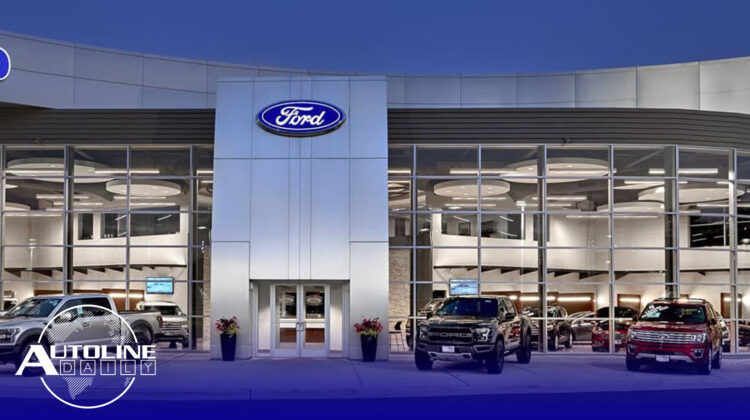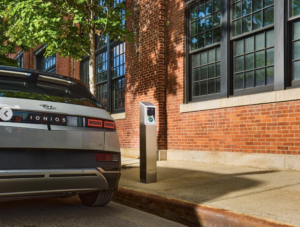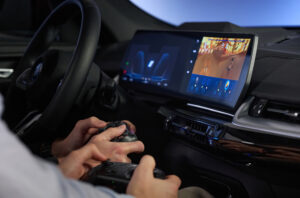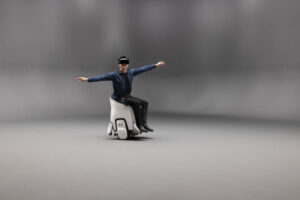
Follow us on social media:
Runtime: 8:47
0:00 Automakers Says California 2035 ICE Ban Won’t Work
1:26 California Considers Speed Limiters on Cars
2:17 European Cities Want Fewer Cars
2:50 BYD Says Mexico Plant Won’t Export to the U.S.
3:57 Boston to Install Curbside EV Chargers
4:59 BMW Unlocks In-Car Entertainment
5:49 Polestar Borrows $950 Million to Keep the Lights On
6:36 Custom Rolls Took 4 Years to Complete
7:34 Honda Creates Expanded Mobility Experience
Visit our sponsor to thank them for their support of Autoline Daily: Bridgestone and Intrepid Control Systems.
This is Autoline Daily, the show dedicated to enthusiasts of the global automotive industry.
AUTOMAKERS: CALIFORNIA 2035 ICE BAN WON’T WORK
California has a mandate to ban the sale of all new ICE vehicles in 2035. And 11 other U.S. states are adopting the same mandate. But the Alliance For Automotive Innovation, which is the lobbying group for most of the automakers operating in the United States, says the ban is not going to work in those 11 other states. It just doesn’t believe enough consumers will buy enough EVs, plug-in hybrids, or fuel cell vehicles to comply with the ban. But one thing’s for sure, we’ll have plenty of warning to know how feasible this is, at least in California. By 2026, 35% of all new vehicles sold in California have to be electric, plug-in or hydrogen fueled. Last year it hit 25%. By 2030 it has to be at 68% and then hit 100% by 2035. In terms of actual sales, last year 445,000 EVs were sold in California. That has to jump to 634,000 in another two years and 1.2 million by the end of the decade. If that many are sold, then the ICE ban will work. If not….then it’s back to the drawing board.
CALIFORNIA CONSIDERS SPEED LIMITERS ON CARS
Speaking of California, a state senator introduced legislation that would mandate all new cars have speed limiters to prevent them from going 10 miles an hour over the speed limit. It would use technology called Intelligent Speed Assist, which would be mandated in 2027 and would rely on GPS to determine the posted speed limit wherever a car is driving. The technology was actually recommended by the NTSB or the National Transportation Safety Board. Europe has already adopted the technology, but it relies on annoying chimes to get a driver to slow down. The California approach would automatically prevent a car from going ten miles an hour over the limit. Although, emergency vehicles would be exempt.
EUROPEAN CITIES WANT FEWER CARS
Meanwhile, in Europe, more cities are trying to get rid of traffic congestion. In Ireland, Dublin is going to ban cars from driving through the city center. The goal is to get rid of 60% of the traffic. And in Greece, Athens is expanding its subway lines to try and get rid of 53,000 cars driving through the city every day. So the automobile sure is coming under a lot of pressure to where it can drive, to how fast it can go, and what kind of fuel it has to run on.
BYD SAYS MEXICO PLANT WON’T EXPORT TO U.S.
U.S. politicians are growing more and more concerned about Chinese car companies entering the market by importing vehicles through Mexico. But BYD, which wants to build a plant in Mexico, says it has no plans to export vehicles from that plant to the U.S. The CEO of BYD Americas says the market is too complicated due to political backlash against Chinese car companies and due to slowing EV demand. But that’s what BYD is saying now and there’s no reason it couldn’t change in the future. And that makes us wonder. With so much excess capacity in China, why would BYD build a plant in Mexico if its long term goal wasn’t getting into the U.S. market?
BOSTON TO INSTALL CURBSIDE EV CHARGERS
One of the biggest complaints about EVs is the lack of a charging infrastructure, especially if you live in an apartment or condo in the city. That’s why Boston is going to install 250 curbside EV chargers around the city. It’s partnering with two companies, Itselectric and Greenspot, which work with building owners to tap into the building’s electricity for Level 2 chargers and they share the revenue they generate with the owners. That means the city won’t have to pay to install the chargers and the chargers don’t need more power lines from the electric utility. The difference between the two companies is Itselectric’s chargers don’t have cords attached. Instead it provides EV owners with a portable cable, which can be plugged in any charger around the city. Greenspot, on the other hand, has built-in cables. Boston building owners will start installing the chargers over the next two years.
BMW UNLOCKS IN-CAR ENTERTAINMENT
BMW customers in Germany and France are able unlock more in-car entertainment features. Owners of models with operating system 8 and higher can now activate things like a Wi-Fi hotspot, video streaming for front seat passengers and Amazon Fire TV for 7 Series owners with the rear theater screen. It’s all done through their My BMW App and cost is 10 euros a month for unlimited data. Most major automakers think they can generate billions with subscription services, but it’s still early days and they’re trying to figure out what people will actually pay for. We believe it needs to be quite compelling, and it has to be something that can’t be easily done on your phone or tablet.
POLESTAR BORROWS $950M TO KEEP THE LIGHTS ON
Earlier this month, Volvo handed most of its stake in Polestar back to its parent company Geely because it couldn’t afford to keep propping up the premium EV brand financially. Polestar says it needs $1.3 billion to keep the lights on until 2025 when it expects to become cash flow positive. And now it has most of that funding. The company announced it raised $950 million from 12 global banks to help keep its 2025 goals on track. Polestar expects big growth in the second half of the year, when the Polestar 3 and 4 reach full production. And by the end of the year, Polestar says it expects to achieve a double-digit gross profit margin.
CUSTOM ROLLS TOOK 4 YEARS TO COMPLETE
Real craftsmanship takes time. And in the case of one Rolls-Royce client, it took 4 years to complete their custom coachbuilt car. This is the fourth car in Rolls’ Droptail series. It’s called Arcadia Droptail and we think it has the most dramatic execution of the rear end with the top up. But just to create the woodwork, Rolls had to come up with unique lacquer that can stand up to multiple environments and develop a carbon fiber substructure to lay the wood veneer over so it would be strong enough not to crack. That alone took more than 8,000 hours. And it took another 5 months to get the clock just right. Even so, Rolls had a record year last year, selling more than 6,000 vehicles and one way it keeps attracting more customers is with custom models like the Arcadia Droptail.
HONDA CREATES EXTENDED MOBILITY EXPERIENCE
Honda is putting VR together with its UNI-ONE, which is like a Segway scooter that you sit in. Debuting at South By Southwest (SXSW), you play a game where you’re floating in the sky or gliding down a halfpipe. The UNI-ONE responds based on whichever way you lean in the seat, which should make it feel like you’re more a part of the game. Honda says it could see a day when it offers an experience like this at theme parks, sporting events and even stores.
That’s a wrap for this show. But don’t forget to tune into Autoline After Hours at 3PM EST time today. Hope to see you then.
Thanks to our partner for embedding Autoline Daily on its website: WardsAuto.com










For now, BYD will just want to increase their sales numbers in Mexico and South America, where they are already selling, but I don’t blame other car companies for being concerned about their “changing their mind” about selling in the US.
It looks like Boston, and Massachusetts in general are far ahead of Florida with EV charging for apartment and condo dwellers, but I wonder about the cost. Is it ~3x the utility rate, like most public charging? If so, EVs aren’t that cheap to run, compared to a fairly efficient ICErs, or especially hybrid vehicles.
If there is any copper at all in those charger attached cables, they will disappear overnight!
Around here the old saying for officers is 9 your fine but 10 your mine. Allowing for people to speed but not more than 10 over. If the vehicles are limited to never exceed 10 over, I would suspect municipalities will need to make up the revenue somehow. Which means ultra pricy fines for just 5 over and officers willing to stop people for even the slightest infraction over the limit. Sounds horrible to me. But that’s par for California.
Mexico has free trade agreements with probably more countries than anyone else. While BYD may change their mind about North America, I think BYD is looking at the rest of the world as a market.
Using GPS as a speed indicator is a problem. We get speed changes reasonably frequently here on two lane roads and not for construction. Our Subaru, Apple and Google systems all fail to keep up with the changes. Just a little thing, but speed sign reading would be more accurate. I should note, I don’t like the idea at all.
Inner city charging with a removable cord that I’m guessing is worth at least $20. Yeah, they won’t have any problem with people stealing them, I’m sure. At least it’s a great step in theory. Boston created the modern day hubcap.
The UK charging system has bring your own cables. Not a bad idea.
@Lambo, speed tickets: I travel to Amsterdam, the Netherlands, 5-6 times per year to visit my mother. I drive around a lot while I am there. Cameras everywhere and automated fines for over 2-3 mph over speed limit (!) It took me a while to understand this. Until my sister told me once that after every visit my mom would pay on average $500 in speeding tickets after I had driven her car for a few days. I apologized to my mom because this had been going on for at least two years without me knowing: “No problem, honey, I am always so happy that you visit me often.”
I pay attention, now, but it remains hard to stay within 2-3 mph from the speed limit. My mom’s car did not have cruise control.
How will there be an ICE ban anywhere for first responder vehicles when the a battery charge wouldn’t last long enough for a shift?
I would strongly support the speed limiter. Too many D$! A@$! drivers around here, make the driving experience for everyone else unnecessarily stressful. Also, think of police chases. Bet that would help the police quite a lot. Next phase would be for police to aim a vehicle and disable it automatically.
That said, @Albermarle is right, municipalities would lose their ability to abuse the speed trap method of closing their budgets, in my view this would be another big plus and likely the biggest hurdle for passing such law.
BYD in Mexico could be for local market as well as US. They have been growing capacity and market share in Latin America already, Mexico is strategically perfect for both.
Wim- Yikes! Yea, not a fan of the traffic cameras either other than at red lights. In my town they just banned them. Plus if it’s not the owner of the vehicle driving, she shouldn’t have to pay the ticket or be required to give information about who was driving her car. But that’s here in the states.
Lambo, charger cables cost more than $20. A small adapter costs more than $20. But at least my car (Volvo) locks the cable in place when the car is locked, you can’t unplug it unless you have the key with you. My previous car didn’t have this feature (Volt), I wonder if others do
Boston’ crackheads will be licking their chops over all the copper they steal from those chargers and cables.
I don’t like the idea of limiting the speed of vehicles to 10 over the posted limit, because it would make overtaking on two lane roads much more dangerous. I like to “expedite” overtaking, sometimes briefly going a lot more than 10 over, but then slowing down to my usual 7-8 over after completing the overtake.
I wish we had red light cameras in the Florida beach town where I am now. Way too many people are running red lights, and it’s especially bad for pedestrians, when 4 or 5 vehicles run the red light when the walk signal is on.
Wim, do you know how the automated fines work for Americans in rental cars? Maybe the rental company would just charge your credit card the extra amount for the fines.
They could use aluminum for the charge cables to make them less a target of thieves. Al has only 61% of the conductivity of Cu, so the wire would need to be bigger, but the Al wire would be lighter in weight.
@Kit: I am pretty sure the rental car company passes on the speed tickets. We were on vacation in Brazil and my son and I rented a car for a twenty-four-hour drive round trip through a very remote area in the far North. My son did not want me to drive “You are too slow, dad, we will never get there if you drive.” The rental car company sent us 20 (twenty, this was unfortunately not a typo) speeding tickets in the three weeks after our return in the States. Guess who paid?
Roger- I figured the charging cable was more than $20. I just picked that number cause if it’s worth anything more than $20 it’ll get stolen. If you do have a lock that just means they’ll damage the car yanking it off the car with force. If anyone can stop the charge I could see them maybe even resorting to cutting the cable. Enough meth and they might try it live. Not to mention fools just messing around and stopping the charge just to be annoying. Hopefully its not much of a problem but it would be a concern for me.
Keeping those charging cables powered at 1000 volts should make them harder to steal.
Wim, do they have automated speed checks reading license tags in Brazil, or is there date logging in the car to give out the tickets?
What about when the speed limit changes downward by 10-20 MPH on a stretch of road and your car brakes suddenly to compensate and the vehicle behind you does not have the limiter installed. Rear end collisions?
It is all about control for a certain group of policy makers in governments. (Stay in your 15 minute city and don’t drive unless your social credit score is good, you have the mandated shot and you have permission to leave or we will shut down your electric vehicle).
Why a charging cord at all? If it can be done in roads, it can be done stationary. https://www.caranddriver.com/news/a45989117/first-wireless-charging-road-north-america-debut/
Wireless charging would waste gigawatts if electricity. Wireless phone charging already does waste megawatts.
Joe G- I too, struggle with policies and laws that seem to just place a tighter grip on people. The America today is a far cry from the America 100 years ago. It’s a battle between doing what’s right for society as a whole and sadly that often times means giving up a little more freedom each time. 100 years ago, you didn’t need the state government permission to drive. Even though they started around 1902 in some states those didn’t even require a test it was more of an ID. States like South Dakota didn’t start issuing drivers licenses until 1954. Then laws like seatbelts or helmets seem to infringe on our personal rights to decide what best for ourselves. The “nanny state laws” that protect us from ourselves. This speed limiting thing I have mixed feelings on. On one hand it provides a safer road for all and in that respect makes sense. However, the rebel in me that enjoys the ability to drive fast or do a burn-out feels like that once freedom is being taken away. Understanding that participating in those activities could endanger someone else that doesn’t want to take that risk. It’s a double edge sword.
100 Years ago, we were more free and certainly less taxed. With each and every tragedy there always seems to be a policy maker willing to give up a little more freedom in order to fix the problem. The obvious debate behind gun control for example. I remember when you could go to the airport and just get on a plane. Back before we have to be X-rayed, felt up, remove our shoes and belts. You could take a drink with you and have your family meet you at the gate. You could visit tourist sites like St Louis Arch without a security check, Go to a ball game without metal detectors. We in Michigan would cross back and forth into Canada easily as a toll road.
Thats just a sample of infringing on things that make us feel free. Then you talk about the money aspect.
Here’s a link to about 50 taxes we pay that didn’t exist 100 years ago.
https://eraoflight.com/2018/02/08/not-one-of-these-latest-taxes-existed-100-years-ago/
“laws like seatbelts or helmets seem to infringe on our personal rights to decide what best for ourselves,”
but we are all paying for those who use their “personal rights” to drive without seat belts and ride motorcycles without helmets, in the form of more expensive health care and medical care insurance.d helmets.
Kit- not really every insurance company I’ve had asks if you wear your seatbelt or wear a helmet. So rates are adjusted accordingly and not passed onto those that dont even ride.